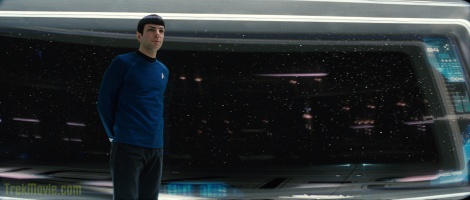I ask again, why would a viewscreen reflect bridge lights?
Unless it where a window made of extra stong glass that turns into a viewscreen when needed. IE, a non-reflective one.
It makes sense, and would look cooler in the film anyway.
Gee, I dunno... MAYBE BECAUSE ANY SHINY SURFACE REFLECTS?!?!?!
A "viewscreen" can be shiny. A window can have anti-glare coating applied. What the HELL are you thinking... that somehow "windows" are always, and inherently, reflective, and that display screens are always, and inherently, non-reflective?
I don't know what planet you live on, but on EARTH, neither of those is the case. My computer monitor happens to reflect lights behind me fairly clearly... but the glass in the picture frame above my desk is matte glass. Funny... I must live in the freakin' mirror universe, huh?
Seriously... how can you possibly think that's a cogent argument?
Calm down dear.
"Dear?"
Simultaneously attempting (though failing) to be belittling while succeeding at coming across as somewhat idiotic... I'm impressed.
The viewscreen on every Star Trek series to date was never shiny or reflective.
That's because the viewscreen on every Star Trek series to date was a blue or green screen and an optical effect. Which, of course, resulted in it LOOKING like an optical effect.
Glass however is, and it would look rather similar to the above pic.
As would any real physical surface whatsoever... with the degree of "shininess" based entirely upon the actual finish, not upon the purpose for which it is intended.
Why would a big computer monitor from the future be made to reflect things unnecessarily? It could be potentially dangerous, and completely pointless
Let me put this into very simple terms. The reason that no viewscreen before has shown any reflection has been because it was a fake-looking visual effect based upon blue- or green-screen techniques. Any REAL viewscreen would, to one extent or another, reflect, much as seen here.
This is not a real physical window on-set, obviously. There is not a real, practical starship hull exterior on-set, just outside of that "window," either. You DO recognize that, I'm sure.
The reason that the reflections were added AS AN EFFECT was to make the item... whether it's supposed to be a window or a viewscreen... look for convincing and less fake. The "no reflection" screens we've always seen always looked fake, because they lacked that visual cue which ALL REAL THINGS would have... regardless of whether the object in question was a window or a viewscreen.
It was, undeniably, overdone... another example of "style versus substance" which seems to be a massive problem with the style of this film. Yes, it would be somewhat distracting.
But do you think that it would be, somehow, "less distracting" if it's reflections on a window than if it's reflections on a display screen? Is that your argument???
Wouldn't the reflections be equally distracting either way?
I agree that it's TOO SHINY. That the bizarre lighting style of that "Revlon Bridge" set is nonsensical in general and reflects quite clearly on that big piece of shiny glass... regardless of whether or not that shiny glass panel is a window or a viewer. I agree that it would be distracting... just like virtually every other feature of that HORRIFICALLY-DESIGNED set is.
I agree that in a well-designed bridge, you would not have the bridge lighting laid out in a fashion which would be able to reflect in that surface, regardless of whether it was a window or a viewer.
I agree that, regardless of whether that's a window or a viewer, you'd have the viewing surface treated with an anti-glare, anti-reflective treatment of some sort.
I just find it DUMBFOUNDING that you somehow think that, due to 40+ years of matte-based special effects in Star Trek substituting for a "real viewer," that somehow means that a "real viewer" would be incapable of reflecting, and that somehow a "real window" would inherently, and invariably, be shiny.




